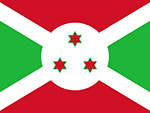 Burundi
Burundi
Facility-Level
Coverage
%
% In Less-Intensive Differentiated Treatment Models
%
Period: June 2022
Source: National DHIS2 and PEPFAR IPs reports
Multi-month ART Dispensing
%
MMD3-5: 89% (66470/75059)
MMD<3: 8% (6372/75059) Period: June 2022 Source: National DHIS2 and PEPFAR IPs report
DART Model
Diversity
FBI (AS+FT; AS w/o FT)
FBG (ART club),
CBI (outreach)
CBG (CAG)
Period: June 2022
Source: National DHIS2 and PEPFAR IPs reports
Burundi joined the CQUIN learning network in October 2020. The Burundian Ministry of Public Health and the Fight against AIDS, through the National AIDS Control and Sexually Transmitted Infections Program (PNLS / STI), has adopted Differentiated Service Delivery (DSD) in the national guidelines since 2016; implementation started in 2019.
The national guidelines for the prevention and treatment of HIV in Burundi adopted in October 2020 emphasize the importance of providing differentiated care to accommodate patient-centric care for the growing number of stable individuals on antiretroviral therapy (ART) and improve continuity of treatment and the impact on their health. The PNLS/STI has developed innovative service delivery models: appointment spacing and multi-monthly dispensing, the establishment of community adherence groups, extension of visiting hours.
These models reduce congestion in health facilities by reducing the frequency of health facility visits and dispensing medication for longer periods. They have improved patient treatment continuity and viral load suppression. Community models will bring services closer to patients and reduce transportation costs for patients. Health care providers’ time will be freed up so they can devote more time to the patients who need it most.
Since Burundi joined the CQUIN learning network, PNLS/STI, with the support of other stakeholders, initiated discussion around diversification of models of differentiated service delivery, including models based in the health facility and in the community, which could reach more recipients of care, enhance the quality of care, and put in place very strong monitoring and evaluation standards.
In Burundi, people living with HIV participate actively in the implementation of the DSD and strategic decision-making processes, playing roles in various technical working groups on DSD, including holding the position of vice-presidency of the national DSD technical committee.
Currently, Burundi is in the process of offering five less intensive models, including:
- An individual model based at the health facility for stable patients: six months multi-month dispensing and appointment spacing.
- A group model based at the health facility: Support groups and/or clubs for adolescents and young people, pregnant women, and key populations
- A community group model: community-based, peer-led groups or Community Adherence Groups (CAGs).
- Two individual community models: community drug distribution points (PODIs) in schools or private pharmacies and provider-led home-based ART delivery (Outreach)
While Burundi is implementing DSD, emphasis is also being placed on strengthening and updating standard operating procedures and monitoring and evaluation tools.
A Burundian team visited Ivory Coast in October 2021 as part of a south-to-south learning exchange supported by CQUIN to learn more about improving the engagement of care recipients in DSD. The knowledge gained during this visit will certainly help improve the implementation of community and facility DSD models and improve the quality of tools and standard procedures.
A national extension plan for DSD is under development to increase the proportion of recipients of care in less intensive models and increase the diversity of models offered.
 Loading...
Loading...

Visit ICAP's Website for a broader portfolio of work in CQUIN network countries.
